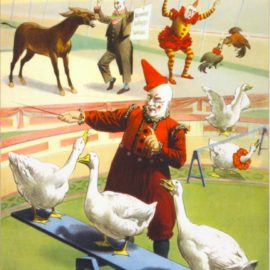
What did Jordan Belfort do to become a financial criminal? What type of financial crimes did he commit?
Though Belfort did many things that were against the law, it was his financial crimes that both enriched him and eventually sent him to prison. So many of Belfort’s business dealings were against federal and state regulations because he invented schemes to hide his transactions from regulatory institutions.
Let’s look at the principles upon which Belfort’s firm, Stratton Oakmont, was founded and the crimes he committed under its name.
Jordan Belfort’s Financial Crimes
In The Wolf of Wall Street, Belfort writes that stockbrokers like himself don’t actually create anything of value, nor do they have any specialized knowledge that gives them insight into the stock market. He says that at heart, stockbrokers are nothing more than sleazy salesmen, and that any kid out of high school or college can be trained to sound like a stock market guru. And thus, he created Stratton Oakmont as a firm comprising young, hungry traders with little financial knowledge but with plenty of motivation to make sale after sale. But what did Jordan Belfort do to make it all fall apart?
(Shortform note: Belfort’s revelation that stockbrokers have no special insight into the market isn’t new. In The Essays of Warren Buffett, the world’s most successful investor derides brokers who encourage investors to trade often and create the illusion that their brokerage services are needed. Buffett argues that stockbrokers’ efforts mainly result in the transfer of wealth away from investors into the hands of investment professionals, skimmed off the top in the form of service fees. These professionals feed off both fear and optimism in the market, recommending trades even in times when investors would be wiser to let their money sit. Furthermore, brokers such as those at Stratton Oakmont bear none of the financial risk their clients take.)
Unlike other unscrupulous traders who preyed on poor investors with what were known as “penny stocks,” Stratton Oakmont made money by preying on the wealthy using inflated stocks that they sold as get-rich-quick schemes. Belfort argues that this strategy worked because most rich people are compulsive gamblers for whom playing at stocks is like going to a casino. Therefore, it’s easy to sell them sketchy stocks, and they trade at higher volumes than less affluent investors. This strategy also confused the Securities and Exchange Commission (SEC), which investigated Stratton Oakmont for years without really understanding the true nature of its business.
(Shortform note: The Securities and Exchange Commission is a US government agency created in 1934 at the height of the Great Depression to regulate the stock market and protect the interests of investors. SEC investigations can be formal or informal, depending on whether there’s evidence of criminal activity or merely the suspicion of such, as seems to have been the case with Stratton Oakmont. While gambling on stocks isn’t illegal—and is actually a common practice—gambling in general is illegal in most US states, prompting banks and brokers to create elaborate financial contracts to shield the gambling aspect of trading from regulation.)
Stock Manipulation
While there are many ways for investment firms to make money, the practice of choice for Stratton Oakmont was stock price manipulation. Belfort’s traders would artificially inflate the stock price of a company during its Initial Public Offering (IPO) while holding on to more shares of that company than was allowed by SEC rules. Belfort illustrates this with the specific example of Steve Madden Shoes, a company that he helped to take public.
Belfort explains how stock manipulation during an IPO works: He’d heavily invest in a new business, such as Steve Madden Shoes, then use his controlling interest to take the company public. Belfort’s brokers would use every strong-arm trick they knew to drive the price up when selling to investors. Once the price had gone high enough, Belfort would sell enough of his shares to recoup the cost of his initial investment—meaning that he paid nothing for the stocks he retained, which were now valued higher than ever. However, by SEC rules, an investment firm sponsoring an IPO is only allowed to own a limited stake in the company whose shares they’re selling—but Belfort and Stratton Oakmont held on to far more Madden stock than they were legally allowed.
Money Laundering
While it’s one thing to make illicit riches, hiding and accessing your money once you’ve earned it poses a new set of problems. Money laundering—the process of converting wealth obtained illegally into seemingly legitimate income—is an industry that Belfort says the Swiss banking system is particularly geared toward, using secret accounts, fictitious corporations, and covert mechanisms to transfer money back to the US under the guise of innocuous transactions.
Belfort traveled to Switzerland in secret, but once he was there, the bankers he met spoke openly about how the Swiss banking system conceals huge sums of money and how it’s their policy to not cooperate with foreign institutions, such as the US’s SEC. Because the practice of issuing “numbered” bank accounts with no name attached stopped after World War II, Belfort’s first step was to open accounts in the names of proxies, much like those who held his stock. These people would have the unenviable task of smuggling large amounts of cash across the border, so Belfort had to use people he could trust who were also unlikely to arouse suspicion—including his elderly British aunt and one of his drug dealers’ Swiss extended family.
To access and control his overseas funds, Belfort writes that his bankers introduced him to a specialist in creating fictitious corporations. This person would generate “bearer companies” that wouldn’t have Belfort’s name on them at all—ownership would be established through physical stock certificates that Belfort would possess. This person would act as Belfort’s corporate proxy, falsifying documents to make his companies look real and conducting business on Belfort’s behalf. For anything Belfort wanted to do—for example, transferring funds from business A to B—this specialist would concoct a paper trail to make the transfer seem justified.
Belfort lists two ways these fake corporations let him move money back to the US. One was by using a US legal loophole called Regulation S, which exempted overseas companies from certain restrictions on US investors. By going through his Swiss businesses, Belfort could invest in the US stock market in ways that he couldn’t as a US citizen. The other way of moving his money back home was through a practice called “transfer pricing,” in which one of his overseas companies would overpay a US business he owned for services or merchandise that may not even exist except on paper. By creating fake companies all over the world, Belfort could move money anywhere under the guise of seemingly mundane business dealings.






